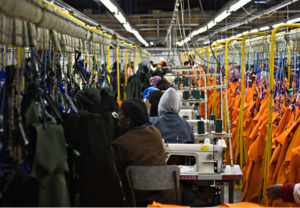The Battle Against Greenwashing in Apparel

Fashion is a powerful form of self-expression, allowing us to convey our identity and style to the world. However, the way fashion is produced and consumed has changed dramatically in recent years. The rise of fast fashion and its environmental and ethical implications has sparked a growing interest in sustainable fashion. But is the fashion industry truly going green, or is it merely a case of “greenwashing”? In this in-depth beauty blog, we will explore the battle between sustainable fashion and fast fashion, examine the issue of greenwashing, and provide insights to help you make conscious choices when it comes to your wardrobe.
Fast fashion refers to the rapid production and distribution of inexpensive, on-trend clothing that aims to quickly respond to the latest fashion trends. This business model has significantly altered the fashion industry in several ways:
- Rapid Turnaround: Fast fashion brands have introduced a remarkable reduction in the time it takes for a design concept to become available in retail stores. This means that they can turn new styles from the drawing board to the hands of consumers in just a matter of weeks, as opposed to the traditional fashion industry’s cycle, which often took months.
- Frequent Collections: In contrast to the traditional fashion model with seasonal collections, fast fashion companies release new collections more frequently. It’s not just spring/summer or fall/winter; they’re continually launching fresh lines, enticing consumers to buy more frequently in order to keep up with the latest trends.
- Low Prices: A hallmark of fast fashion is its affordability. These brands offer clothing at remarkably low prices, democratizing fashion and making it accessible to a much broader audience. This accessibility has revolutionized the way people approach shopping for clothing.
- Global Production: Fast fashion thrives on global supply chains, leveraging production in countries with lower labor costs. This global approach allows brands to keep prices down, but it also raises questions about ethical labor practices and the environmental impact of long-distance shipping.
- High Environmental Impact: The rapid and continuous production of inexpensive, disposable clothing carries a substantial environmental cost. The push for quick fashion turnover contributes to high levels of textile waste and pollution, as well as resource consumption, including water and energy.
- Consumer Expectations: Fast fashion has shifted consumer expectations, fostering a culture of immediacy. The ability to purchase trendy items at low prices and have them almost instantly has reshaped how people perceive clothing. Consumers have grown accustomed to having the latest styles readily available, and this has implications for both their shopping habits and the fashion industry’s environmental impact.
- Societal Implications: The rise of fast fashion has brought with it both social and ethical concerns. The pressure to produce clothing quickly and inexpensively can lead to poor working conditions and low wages for factory workers, particularly in countries with weak labor regulations. Ethical labor practices are often sacrificed in the pursuit of low costs and high turnover.

Sustainable Fashion: A Growing Movement
Sustainable fashion is a response to the negative consequences of fast fashion. It focuses on creating clothing in a way that considers the social, environmental, and economic impacts of the fashion industry. Here are some key aspects of sustainable fashion:
- Ethical Labor Practices: At the heart of sustainable fashion is a commitment to ethical labor practices. Brands that embrace sustainability prioritize fair wages, safe working conditions, and workers’ rights. They often collaborate with manufacturers who share these principles, striving to create a more equitable and just fashion industry.
- Eco-Friendly Materials: Sustainable fashion places a strong emphasis on using eco-friendly materials. These materials can include organic cotton, recycled fabrics, and natural dyes. The goal is to reduce the environmental impact of clothing production, from the sourcing of materials to the manufacturing process.
- Transparency: Transparency is a cornerstone of sustainable fashion. Many sustainable brands offer a transparent supply chain, allowing consumers to trace the journey of their clothing from production to purchase. This transparency builds trust and empowers consumers to make informed choices.
- Quality Over Quantity: Sustainable fashion promotes a shift from disposable, fast fashion to a more mindful approach. Instead of encouraging consumers to buy frequently, it encourages them to invest in fewer, high-quality items. These items are designed to last, reducing the need for constant replacements.
- Local Production: Some sustainable brands focus on local or domestic production. By manufacturing clothing closer to the point of sale, they reduce the carbon footprint associated with long-distance shipping. This not only benefits the environment but also supports local economies.

The Battle Against Greenwashing
Greenwashing is a deceptive marketing practice where a brand portrays itself as environmentally friendly or socially responsible without actually implementing sustainable practices. This tactic can mislead consumers who genuinely want to make eco-conscious choices.
To distinguish between genuine sustainability and greenwashing, here are some key factors to consider:
- Certifications: Look for recognized certifications, such as Fair Trade or GOTS (Global Organic Textile Standard), which ensure certain ethical and environmental standards are met.
- Transparency: Brands that are genuinely committed to sustainability are often transparent about their practices, materials, and supply chains.
- Material Sourcing: Investigate the materials used in clothing production. Sustainable brands often use organic or recycled materials.
- Quality vs. Quantity: Consider whether the brand promotes long-lasting, high-quality clothing over disposable fashion.
- Ethical Labor Practices: Investigate the brand’s stance on labor practices, including fair wages and safe working conditions for factory workers.
- Community Engagement: Sustainable brands often engage with local communities and support causes related to social and environmental issues.
The fast fashion industry has a significant environmental impact. Here are some of the ways it contributes to environmental degradation:
Waste Generation: Fast fashion encourages the disposal of clothing, leading to high levels of textile waste.
Chemical Pollution: The use of synthetic materials and dyes can release harmful chemicals into the environment.
Resource Depletion: The production of cheap clothing consumes vast amounts of water, energy, and other resources.
Greenhouse Gas Emissions: Long-distance shipping and transportation contribute to carbon emissions.
Microplastic Pollution: Synthetic fabrics shed microplastic particles into waterways when washed.

The Benefits of Sustainable Fashion
Sustainable fashion offers several advantages over fast fashion:
- Reduced Environmental Impact: Sustainable fashion aims to minimize resource consumption, waste generation, and pollution.
- Ethical Labor Practices: It promotes fair wages and safe working conditions for garment workers.
- High-Quality Clothing: Sustainable fashion often results in better-quality garments that last longer.
- Supports Local Economies: Brands that prioritize local or domestic production help support local communities.
- Transparency: Sustainable brands are often more transparent about their practices, allowing consumers to make informed choices.
- Unique Style: Many sustainable brands offer unique, artisanal pieces that stand out from mass-produced clothing.
- Personal Connection: Consumers often feel a more personal connection to the brands and products they choose, knowing they align with their values.
Making sustainable fashion choices can be a powerful way to reduce your environmental impact and support ethical practices in the industry. Here are some tips to help you get started:
Educate Yourself: Learn about sustainable fashion, greenwashing, and the environmental and social impacts of the industry.
Prioritize Quality: Invest in high-quality clothing that will last longer, reducing the need for frequent replacements.
Buy Secondhand: Consider purchasing secondhand clothing to extend the life of existing garments and reduce waste.
Support Sustainable Brands: Research and support brands that prioritize sustainability and ethical practices.
Reduce, Reuse, Recycle: Follow the principles of the circular economy by reducing consumption, reusing items, and recycling clothing when it reaches the end of its life.
Mend and Care: Learn basic sewing skills to mend clothing, and take good care of your garments to make them last.
Choose Natural Fibers: Opt for clothing made from natural, biodegradable materials like organic cotton, hemp, or linen.
Wash Mindfully: Use cold water, eco-friendly detergents, and microfiber-catching washing bags to minimize microplastic pollution.
Participate in Clothing Swaps: Organize or attend clothing swap events to exchange garments with others.
Advocate for Change: Support policies and initiatives that promote sustainability in the fashion industry.
Sustainable Fashion in Beauty
The principles of sustainable fashion can extend to your beauty routine. Many beauty brands are now embracing sustainable practices by offering eco-friendly packaging, reducing waste, and using natural and clean ingredients. Here are some ways to incorporate sustainability into your beauty routine:
- Eco-Friendly Packaging: Look for beauty products that use minimal or recyclable packaging.
- Clean Ingredients: Choose products made with clean, natural, and non-toxic ingredients.
- Cruelty-Free: Support brands that are cruelty-free and do not test on animals.
- Refillable Options: Some beauty brands offer refillable packaging, reducing waste from single-use containers.
- Minimalism: Embrace a minimalist beauty routine by using fewer, high-quality products.
- DIY Beauty: Explore making your own beauty products with natural ingredients at home.
The battle between sustainable fashion and fast fashion is a critical issue in the modern world. While fast fashion has transformed the way we consume clothing, it comes at a significant environmental and ethical cost. Sustainable fashion offers a more responsible and conscious approach to dressing, emphasizing ethical labor practices, eco-friendly materials, and transparent supply chains. However, the challenge lies in distinguishing genuine sustainable brands from those that engage in greenwashing.
Making sustainable fashion choices empowers consumers to reduce their environmental impact and support ethical practices in the fashion industry. As the sustainable fashion movement grows, it is not only reshaping the clothing we wear but also extending to other aspects of our lives, including beauty products. By prioritizing sustainability in fashion and beauty, we can contribute to a more environmentally conscious and ethical world.

